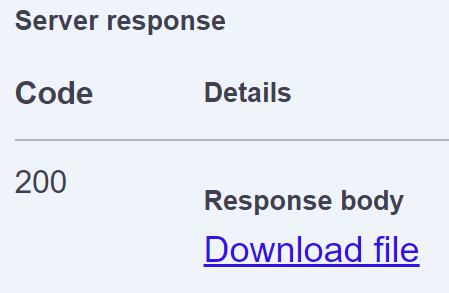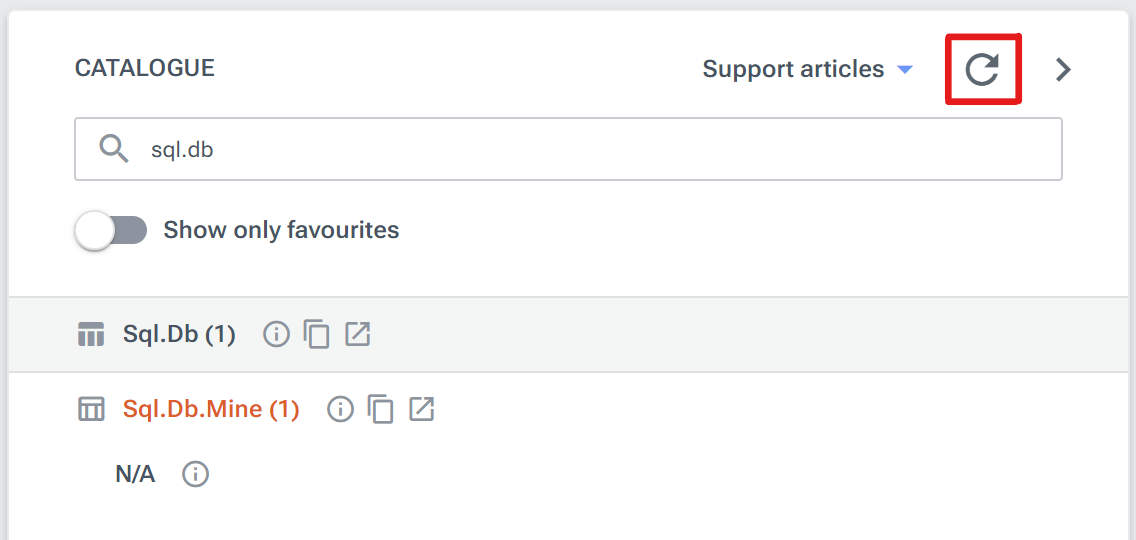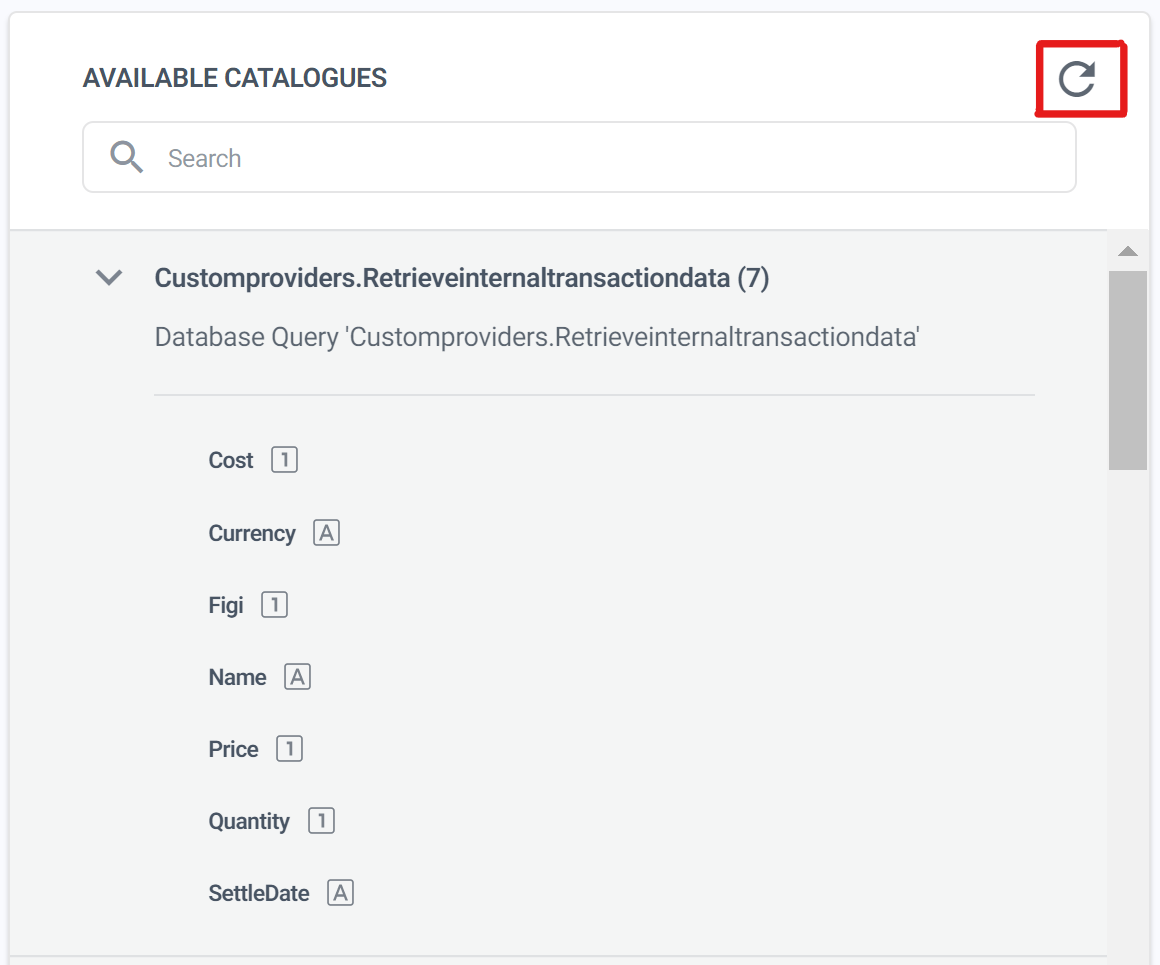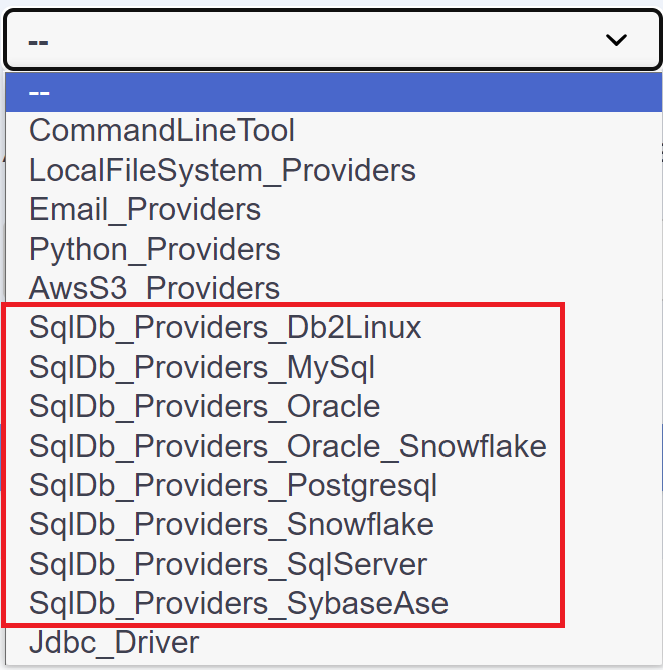You can request a Sql.Db.Mine provider from FINBOURNE and run it locally to create and publish a custom provider in your LUSID domain that is able to read from, write to, or configure your own SQL database.
Note: You can connect to the following databases: DuckDb, MySql, Odbc, Oracle, PostgreSQL, SqLite, SqlServer, GoogleBigQuery, AwsAthena, Db2, Snowflake.
The goal is to enable end users to write simplified or more performant queries using the custom provider available from your domain's Luminesce catalog rather than interacting with the database directly, which they might not have the knowledge, infrastructure or permissions to do.
Note: To query your custom provider, an end user must have a valid user account in your LUSID domain, and suitable access control permissions to use that custom provider. More on permissions.
Consider the example of a CustomProviders.RetrieveInternalTransactionData custom provider you publish that:
Retrieves particular transaction data from your database in a highly performant manner, for example instrument names, unique identifiers, settlement dates, quantities and prices.
Calculates the cost of each transaction on-the-fly by multiplying quantity by price.
An end user can then write a simple Luminesce SQL query that retrieves data from your SQL database and processes it, perhaps by upserting it to LUSID. For example, the following query uses CustomProviders.RetrieveInternalTransactionData to retrieve all the transactions that occurred on 22 April 2022, and then the Lusid.Portfolio.Holding.Writer provider (supplied by FINBOURNE) to set them as holdings in LUSID.
Note: The column names retrieved from your database must match those expected by the FINBOURNE provider (hence some have been renamed).
Hosting the Sql.Db.Mine provider
To run Sql.Db.Mine locally:
Make sure your computer has .NET 8 installed.
Note: Version 1.17.X and below of the SQL providers binary requires .NET 6.
As a LUSID user with the
lusid-administratorrole, navigate to<your-domain>.lusid.com/honeycomb/swagger/index.html, where<your-domain>is the root of your LUSID domain, for exampleacmecorp. If you do not have thelusid-adminstratorrole, see the appendix.Use Swagger's Try it out button for the
DownloadBinaryAPI to request the appropriateSqlDb_Providers_*binary, for example for PostGreSQL:

Click the Download file link in the response to download the binary to your browser's download location:

Navigate to the download location and run an appropriate install command (omitting the
.nupkgfile extension), for example for PostgreSQL:You can locate the installation:
Windows:
%USERPROFILE%\.dotnet\tools\.store\Linux/MacOS:
$HOME/.dotnet/tools/.store/
Run the following command to start the service (omitting the
.exeextension on Linux or MacOS):...where
<your-domain>is the root of your LUSID domain, for example--authClientDomain=acmecorp. TheDownloadMayMintoption mints a new certificate if you do not have one already. Read more on managing certificates.
For information on all the command line options, run the commandluminesce-database-providers.exe --help.Note
The above command shows a user setup; once you are ready to make your providers globally available you can switch to
--routeAs=Global. You may need to switch to global routing if you experience the following error:When prompted in a browser window, authenticate to LUSID as a user with administrative privileges.
With the Sql.Db.Mine provider running locally, you can now write a Luminesce SQL query using any tool, for example the LUSID web app. Note the following:
You may need to click the Refresh button in the web app catalog (highlighted in red) to see
Sql.Db.Mine.FINBOURNE host a
Sql.Dbprovider that may also appear in your catalog. Do not use this. UseSql.Db.Mine.You can rename
Sql.Db.Mine.

To stop Sql.Db.Mine, press CTRL-C. To start it again, rerun the luminesce-database-providers.exe command (it should be faster subsequent times). Your LUSID credentials are remembered for one hour, after which you must authenticate again.
To uninstall the package, perhaps in order to upgrade to a newer version, run the command dotnet tool uninstall Finbourne.Luminesce.DbProviders.PostgreSql -g.
Understanding access control permissions
You, and any other LUSID administrative user wishing to run queries against Sql.Db.Mine in order to publish custom providers for end users, must have access control permissions to use the Sql.Db.Mine provider. The general principle of creating policies for Luminesce providers, assigning them to roles and roles to users, is explained in this article. Note you should automatically have permission if you are the LUSID domain owner with the built-in lusid-administrator role.
You, and any other LUSID administrative user wishing to run queries, should also have access control permissions to use connection string aliases in order to connect Sql.Db.Mine to your SQL database.
Your end users should not have access control permissions to use Sql.Db.Mine. Instead, they require access control permissions just for those published custom providers you wish them to use.
Renaming Sql.Db.Mine
You can optionally rename the Mine suffix (though not the Sql.Db prefix). To do this, open <binary-install-loc>/api-settings.json and change:
to (for example):
The new name is reflected in the Luminesce catalog the next time you sign in. Note you will need to restart Sql.Db.Mine if you change this file while the service is running.
Connecting to your SQL database
You can connect to any supported SQL database for which you have a valid connection string.
You can hard-code the connection string in the provider (using the --connection option), and this might be more convenient when creating and testing your provider.
For publication, however, we recommend specifying a connection string alias in <binary-install-loc>/database-provider-settings.json, for example:
You can then use the alias Name with the --connection option. Note you will need to restart Sql.Db.Mine if you change this file while the service is running.
To connect via aliases you must also create a policy consisting of the following JSON, assign it to a suitable role, and assign that role to your LUSID user (or any LUSID administrative user wishing to run queries against Sql.Db.Mine):
Getting help
You can access the latest documentation in the help page for the Sql.Db.Mine provider at any time by running this query:
Alternatively, run the following query to retrieve the help content as a table:
Understanding the Sql.Db.Mine provider syntax
Sql.Db.Mine is a direct provider, and therefore follows these syntactic conventions.
The precise syntax is as follows:
Note the following:
Each
<section>must be separated by a line consisting of at least four hyphens (and no other characters).<options-section>
An option takes the form--<option>=<value>, for example--provider=Provider.MyProvider. Note no spaces are allowed either side of the=operator. If an option takes a boolean value, then specifying that option (for example--allDomains) sets it to True; omitting the option specifies False.
The--typeand--connectionoptions are mandatory. To list all the options, access the help page and examine the table at the bottom. The options in the following table are particularly relevant:Option
Explanation
--typeMandatory. Valid arguments are:
MySql,Odbc,Oracle,PostgreSql,SqLite,SqlServer,GoogleBigQuery,AwsAthena--connectionMandatory. This can either be:
A connection string, for example
--connection="Data Source=./Tests/TestData/sakila.sqlite;"The
Nameof a connection string alias, for example--connection="MyDb"
--provider=<name>Mandatory in order to publish your custom provider with the specified name in the Luminesce catalog, for suitably-permissioned end users to discover and query. Note it may be more performant to omit this option while creating and testing your provider.
--withWriterMandatory if you include a
<sql-for-writing-section>in order to write to your SQL database.--commitEvery=<value>When writing data, performs a commit every
<value>rows. For example, specifying--commitEvery=10000performs a commit every 10,000 rows. If this option is not specified, one commit is performed at the end of the operation; if an error occurs, all data the operation has written so far is cancelled.--parameters <name>,<type>,<value>,true/false[,description]Defines scalar variables that can be passed into the custom provider by end users. Each declaration:
Must be on a separate line after
--parameters, so if specified this option should always be last in the list.Must have a name and data type (either
Boolean,Int,BigInt,Double,Decimal,Text,Date,DateTime).Must have an initial value appropriate to the data type. To include quote or comma characters in a
Textvalue, encapsulate it in double quote marks (see the example below). Specifytrueas the fourth argument to make the initial value also the default value; specifyfalseto use the initial value only when setting up the provider, and not when end users query the published version.Can have a description that appears as a tooltip for end users in the Luminesce catalog. To include quote characters in the tooltip, encapsulate them in double quote marks:
See also the
#PARAMETERVALUEmacro in the section below for inserting parameter values into the provider at the appropriate location.--deleteProviderRemoves a published provider from the Luminesce catalog. More information.
--limit=<n>--offset=<n>--groupBy=<pipe-delimited(|)-set-of-expressions-to-group-by>--select=<pipe-delimited(|)-set-of-expressions-to-filter-by>--filter=<filter-expression>--distinctSpecifying these options optimises performance in conjunction with the appropriate macros (see the section below) while you are creating and testing the custom provider. Consider the following example:
Each time you run this query during the development phase, a maximum of 42 different bonds with ISIN identifiers is returned, enabling you to test the provider returns meaningful data in a reasonable timeframe.
Note these options have no effect on a published provider, so you can either retain or omit them when you are ready to add the--provideroption and go live.<sql-for-reading-section><sql-for-writing-section><sql-for-configuring-section>
Nominally optional, at least one of these sections is mandatory in order for your custom provider to perform a useful operation. They must be in the specified order. AnENDUSEstatement must terminate whichever is the last of these sections.
Reading from your SQL database
You must write a SQL query in the <sql-for-reading-section> that is valid for the SQL database you are connecting to.
We recommend including the macros in the following table in your SQL query to optimise performance.
Note: For more information on each macro, and for available macros that are not included below (such as
#CHECKACCESS,#USERIDand#CLIENTDOMAIN), access the help page.
Macro | Use # of times | Explanation |
|---|---|---|
| Many | Optimises the performance of retrieving data from your SQL database. Each …specifies that an end user can write a query returning an You could omit the …but this would impair performance. The custom provider will always retrieve the
For example: |
| One | Use this macro once instead of |
| Many | Optimises the performance of any |
| One | Use this macro once instead of |
| Many | Inserts the named Note parameters with a data type of |
| One | Inserts a |
| One | Fills in the |
| One | Inserts a |
| One | Inserts a |
| One | Allows more limits to be applied, and in the case where they exist can significantly optimise performance. Requires the presence of both |
For example, to create our example CustomProviders.RetrieveInternalTransactionData provider:
Note the following:
When run, this query publishes a
CustomProviders.RetrieveInternalTransactionDataprovider in the Luminesce catalog.An end user can filter/return seven columns from the SQL database table (
Name,Figi,SettleDate,Currency,Quantity,PriceandCost).Values in the virtual
Costcolumn are calculated on-the-fly by multiplying the databasepricebyunitscolumns.If an end user writes a query that aggregates any of the columns in the
SELECT_AGGmacro, the aggregation is passed down by theRESTRICT_AGGmacro to the SQL database, improving performance. An example of such a query might be:
Writing to your SQL database
In addition to a SQL query in the <sql-for-reading-section>, you can specify the --withWriter option and write a SQL query in the <sql-for-writing-section>. This creates a writer provider, alongside the read provider, that end users can use to write to the SQL database.
For example, to create a CustomProviders.RetrieveInternalTransactionData.Writer provider:
This publishes two providers in the Luminesce Catalog: a read provider CustomProviders.RetrieveInternalTransactionData and a write provider CustomProviders.RetrieveInternalTransactionData.Writer.
Note: The SQL required for the <sql-for-writing-section> varies depending on the database type you’re connected to. Appendix B provides an example of the form required for each supported database type.
We recommend including the macros in the following table in your SQL query to optimise performance. For more information on each macro, and for available macros that are not included below, access the help page.
Macro | Use # of times | Explanation |
|---|---|---|
| One | Passes column names the end user specifies down to the SQL database. Use the For example: |
| One | Assigns values to columns and passes them down to the SQL database. |
| One | Specifies how to assign values to columns. Use the For example: …assigns column values in the event of a conflict with |
| One | Applies column assignments from |
Configuring your SQL database
You can use Sql.Db.Mine to create a new database table if one does not already exist in the --connection location. For example:
…creates a table my_database_table with the columns instrument, figi, txn_date, currency, units, price, updated_at and created_at.
Note you must specify a <sql-for-reading-section> and <sql-for-writing-section> when configuring your database using Sql.Db.Mine. This means the query creates a table and also publishes:
A read provider, for example
CustomProviders.RetrieveInternalTransactionDatathat users can query to read frommy_database_table.A write provider, for example
CustomProviders.RetrieveInternalTransactionData.Writerthat users can query to write tomy_database_table.
Publishing your custom provider
Each time you run a query with the --provider option, a custom provider with the specified name is automatically created and made available in the Luminesce catalog (note you may need to click the highlighted Refresh button to see it):

Note: It is more performant to omit the
--provideroption while you are creating and testing your provider.
To grant end users the necessary permissions to query a custom provider, create a suitable access control policy and assign it to each LUSID end user.
Once published, an end user can write Luminesce SQL queries using any of the data fields published in the catalog, so for example:
Managing your live custom provider
Once published, you can manage a custom provider by running queries, for example:
To retrieve the original query used to create the view:
To examine the current content of the view:
Routing your providers globally
After setting up and testing your providers as a single user, you can specify --routeAs=Global in your start-service command to make the database configuration global.
To make the switch from user to global, you may need to first delete existing certificates from your binary installation location. For a default Windows installation, this can be found in %USERPROFILE%\.dotnet\tools\.store\finbourne.luminesce.dbproviders.<*>\<version>\finbourne.luminesce.dbproviders.<*>\<version>\tools\net8.0\any:

Once any existing certificates have been deleted, the start-service command will automatically download the required domain-wide certificates when it next runs. For example, you could run:
Important
Setting the
DataProvider:RoutingTypeGlobalMachineWhitelistconfig option to your device name explicitly grants permission for users with suitable access control permissions to access and pull data from files on your machine. Ensure you have set up the correct access control permissions before running the command.
Read more on certificate management for Luminesce providers.
Deleting your custom provider
To remove a custom provider from the Luminesce catalog (which means it will no longer be available for end users to query), run your query with the --deleteProvider option. For example:
Note if using Oracle, you must supply a from for your select 1 as deleting statement. For example:
Appendix A: Allowing non-administrative users to download binaries
Once a license is granted, users with the lusid-administrator role have permission to download any SqlDb_Providers_* binary out-of-the-box.
To enable less privileged users to download, create a feature policy consisting of the following JSON, assign it to a role, and the role to their LUSID user. Make sure the code in the policy matches the download binary name:

So the code for PostgreSQL is as follows:
Appendix B: Syntax for writing to different SQL database types
The form required of your query to write to your SQL database can greatly vary by database type. The following table provides an example of the required SQL query form for each supported database type:
SQL database type | SQL query example |
|---|---|
PostgreSQL | |
SQLite | |
DuckDb | |
Oracle | |
MySql | Coming soon |
Odbc | Coming soon |
SqlServer | Coming soon |
GoogleBigQuery | Coming soon |
AwsAthena | Coming soon |
Db2 | Coming soon |
Snowflake | Coming soon |
